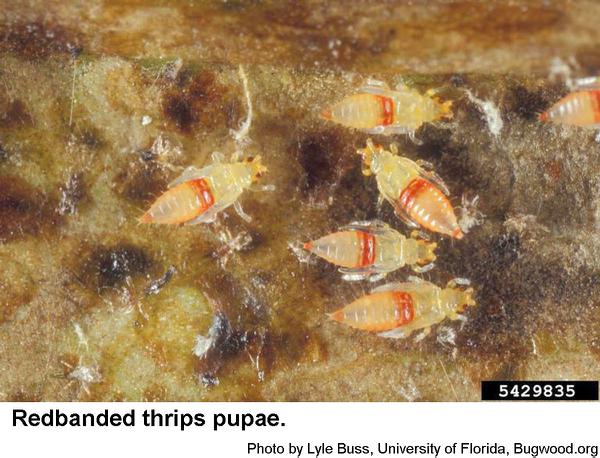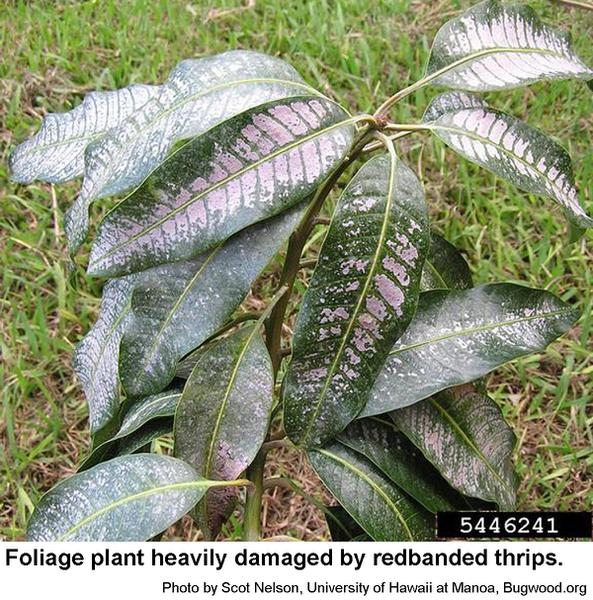Description and Biology
The redbanded thrips, Selenothrips rubrocinctus, invaded Florida some years ago from the West Indies. Redbanded thrips are so called because of the bright red band across the middle of the pale immature stages. Adults are tiny (1/16 inch long) and dark to black with alternating pale and dark segments of the antennae. Adults also have the red band, but the band is usually obscured by their dark pigment. Feeding is almost entirely on foliage and fruits with this thrips most abundant on inner parts of host plants. All stages are usually present at the same time. The minute, kidney-shaped eggs are inserted in leaves and fruit. Females form a small, dark "blister" above each egg by excreting a liquid that soon dries. Females lay 25 to 50 eggs. Development is relatively slow (up to six weeks from egg to adult).
Host Plants
In Florida redbanded thrips infest avocado, guava, mango, and sweet gum as well as numerous host trees, shrubs, and flowers. Infested leaves have small, pale spots on top. Heavy damage causes russeting. Infested plants become silvery or bleached and the leaves become papery and wilt or die. The leaves and fruit become spotted with tiny, dark drops of excrement. Undersurfaces have pale spots, drops of excrement, and the thrips themselves.
Residential Recommendations
Redbanded thrips are the prey of natural predators such as spiders, mites, lacewings, bugs and even other species of thrips that are predatory. These natural controls are effective most of the time. Should this thrips become too abundant, redbanded thrips are not particularly resistant to pesticides. The neem seed extracts, pyrethrums, pyrethroids, and Orthene should all give adequate control. When used as directed, pyrethroids are very toxic to insects but are not particularly hazardous to humans and pets (other than fish-avoid using pyrethroids around pools, ponds, and streams). Most of the insecticides found in plant centers and big box stores that are labeled for residential use in the landscape should also control redbanded thrips.
References
- Common name: redbanded thrips, scientific name: Selenothrips rubrocinctus (Giard) (Insects: Thysanoptera: Thripidae). Denmark, H. A. and D.O. Wolfenbarger. 2019 (reviewed). Featured Creatures. Entomology & Nematology, FDACS/DPI, EDIS, Publication Number: EENY-99.
- Insect and Related Pests of Flowers and Foliage Plants. Baker, J. R. ed. 1994 (revised). North Carolina Cooperative Extension Service publication AG-136.
- Thrips of Ornamentals in the Southeastern US. Funderburk, J., S. et al. After 2007. University of Florida, IFAS Extension. Publication ENY-845.
- Extension Plant Pathology Publications and Factsheets
- Horticultural Science Publications
- North Carolina Agricultural Chemicals Manual
For assistance with a specific problem, contact your local Cooperative Extension Center.
This Factsheet has not been peer reviewed.
Publication date: Sept. 27, 2017
Reviewed/Revised: July 6, 2022
Recommendations for the use of agricultural chemicals are included in this publication as a convenience to the reader. The use of brand names and any mention or listing of commercial products or services in this publication does not imply endorsement by NC State University or N.C. A&T State University nor discrimination against similar products or services not mentioned. Individuals who use agricultural chemicals are responsible for ensuring that the intended use complies with current regulations and conforms to the product label. Be sure to obtain current information about usage regulations and examine a current product label before applying any chemical. For assistance, contact your local N.C. Cooperative Extension county center.
N.C. Cooperative Extension prohibits discrimination and harassment regardless of age, color, disability, family and marital status, gender identity, national origin, political beliefs, race, religion, sex (including pregnancy), sexual orientation and veteran status.



